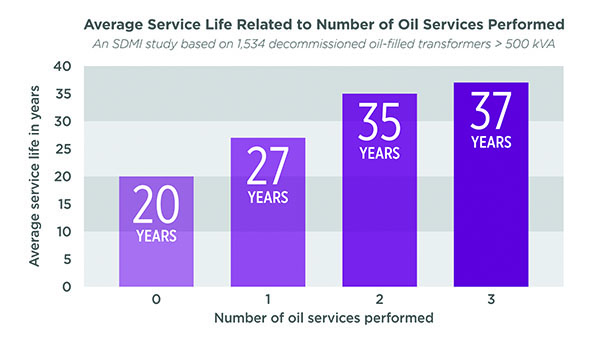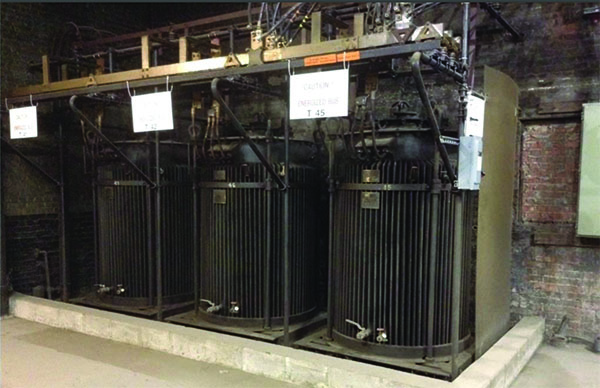Transformer Reliability: An Overview of Data-Driven Decision-Making
Are you properly quantifying and assessing the health of your plant’s transformers? Oil testing, infrared scanning, electrical testing, and inspection provide a much deeper understanding of what is happening inside transformers. Using trend analysis, it’s possible to see faults develop early enough to mitigate them before they become a threat to reliability.
The last time I flew internationally it was quite uncomfortable. The airplane seat was much smaller than I remembered. The seatbelt was snugger. My elbows had nowhere to go. The passenger in the seat in front of mine—with whom I’d had a polite conversation before boarding—became a source of seven hours of frustration when she reclined her seat to go to sleep, sending the edge of the folding tray one inch deep into my abdomen.
Had the entire aircraft shrunk? Was I imagining it? What does this anecdote have to do with industrial power transformer reliability? Don’t worry. I’m getting there. But first, let me tell you what my doctor said.
My doctor was convinced that the plane hadn’t shrunk. I’d grown. I was out of shape, she said, and I hadn’t even noticed because I’d been so busy with everything else in my life. She showed me the data. I concurred. We decided to perform some reactive maintenance to mitigate further risk of failure.
This was her maintenance plan: Track everything. Compare myself to healthy people who are my age and gender. Understand that data and act upon it right away by making informed and intelligent decisions on what to eat and when to exercise.
I love analytics. I spent six weeks tracking every metric I could. I soon noticed trends in the data. I cut out some of the things that were causing faults and added activities that were beneficial. I turned it around. The stakes are high. I did what it took to get the numbers back to “normal” ranges, so I could again focus on everything else in my life. The next time I fly, I’ll fit.
Tracking Transformer Health
Many transformer owners experience declining transformer health in much the same way. Everything seems fine, until it doesn’t. Fluid test results are good for years and then, suddenly, there is evidence of a brand-new incipient fault.
There’s never a good time to discover a transformer fault. Stakes for transformer failure are very high, too, but not just on an individual level. If a transformer fails, it can take down a production line or an operating room immediately, or it can shutter an entire operation for days, weeks, or even months until it is replaced. Careers have been ended by unexpected transformer failure, and capital expenditure budgets rarely consider replacing these fundamental (and extraordinarily expensive) assets.
 |
|
1. Transformer reliability is driven by data. Even broad comparisons, like the number of oil services performed compared to the life of a unit, offer insights into just how valuable intelligent testing and maintenance can be. Courtesy: SDMyers |
Transformer health, much like human health, can be quantified and assessed. Oil testing, infrared scanning, electrical testing, and inspection provide a much deeper understanding of what is happening inside the transformer. By observing the changes in those data points over time—trend analysis—it’s possible to see faults develop early enough to mitigate them before they become a threat. This is how we know, for example, that the more oil services that are performed on a transformer, the longer it lives (Figure 1).
Not all transformers are created equal, however, and not all transformers require the same level of vigilance and care. Remote monitoring hardware is becoming more and more widespread, with single-gas monitoring systems keeping a finger on the pulse of some transformers, reporting back hydrogen levels and acting as the early warning system for when something has started to go wrong. Five-gas monitors and nine-gas monitors provide more data, allowing for more-nuanced diagnostics and more-accurate assessment of overall health.
A helpful rule of thumb for which of these monitoring systems to purchase is criticality; a transformer that powers the lights and gates at an underutilized storage facility might be less critical than, say, one that powers a highly profitable production line or an electric arc furnace. The latter examples are so important because failure would be mission critical—it would affect the company’s mission and would incur significant losses in terms of production shutdown. In an electric arc furnace, the stakes are even higher; unintentionally cooled steel throughout the line must be cut out at great expense in terms of labor and replacement equipment.
Transformer reliability is about developing and maintaining low-cost electric power systems. Unnecessary expense, then, is counter to that concept. The adage “you can’t buy your way to reliability” is certainly true for transformers. A 50-year life isn’t necessarily guaranteed by spending more money on testing or performing maintenance for the sake of it.
 |
|
2. Older transformers have proven themselves to be long-lasting workhorses, and with proper maintenance can last for decades beyond their expected life. The transformers pictured here were installed a century ago. Courtesy: Greg Hunger |
The same goes for upgrading and replacing equipment based on age alone. Counterintuitively, it may be possible that newer transformers are less reliable in the long term than their older counterparts due to the incredible precision with which legacy components were built. The theory goes that there was much more human involvement in the construction of older transformers, and that that accountability led to older units being over-engineered. This may be the reason that, with a rigorous maintenance plan and regular testing, it became reasonable to expect a half-century lifespan for that equipment. There still are some Allis-Chalmers single-phase transformers in service that are more than 100 years old (Figure 2).
If criticality tells us which transformers to monitor more closely and which ones require only the high-voltage equivalent of a “check engine” light, does that mean that some transformers are essentially disposable? Not quite. It’s important to note that the distinction in criticality is not a case of flippancy versus conscientiousness; “more data” isn’t synonymous with “the best fit for our equipment.” Rather, there are only so many dollars in the budget, and to overspend on the collection of data that is not going to be used to its full potential is a waste. All of this data, whether collected from oil sampling, the inspection process, or remote-monitoring hardware, is only valuable if it is being used.
How to Maximize Transformer Longevity
Without the correct tools for trend analysis, leveraging your transformer data may prove easier said than done. With vast amounts of equipment to monitor, larger organizations and manufacturers use computerized maintenance management systems (CMMS) to track the health of their equipment and to issue work orders when things go wrong.
The problem with relying on a CMMS is that a critical component of the way they work is by using the mean time between failure (MTBF). For many transformers, the MTBF can be 20, 30, or 40 years. Most CMMS software doesn’t fit intervals of that duration, so transformers (and other components in the high-voltage system) are rarely included. It’s outside the building, behind a fence, and absent from the CMMS. Out of sight, out of mind.
Electric power reliability is a vital aspect of an organization’s reliability plan, and reliability practitioners are becoming increasingly successful at making that case within their organizations. To fill the gap in the CMMS, major organizations and utilities develop proprietary software to track the health of the equipment they maintain. For smaller organizations, and companies with more constrained budgets and fewer assets to track, specialized transformer management firms provide web-based dashboards that automatically generate reports and graphs that allow for sophisticated analysis, regardless of the size of the fleet.
It’s easy to get carried away with the technical aspects of reliability and the data that testing, inspection, and monitoring provide. But transformer reliability is not a purely digital process; it’s a synthesis of intelligent analytical tools and human wisdom. When that software is linked with human subject-matter expertise, issues can be addressed immediately, which decreases the risk of unexpected failure and allows for more accurate maintenance planning and budgeting.
For example, when transformer owners receive a test result that falls in the “unacceptable” range, what does that mean? Will the equipment fail overnight or will it be fine to ride out that fault for the next 40 years? Is it necessary to remediate right away or can it wait a few months? In these instances, transformer maintenance professionals can look not only at trends within the plant, but they also can seek out trends across the entire industry by looking at how similar pieces of equipment in similar applications have performed, then gauge how those faults actually have affected the transformer’s reliability.
By comparing the transformer to others around it, new trends emerge. Perhaps that fault, on that exact piece of equipment, makes no tangible difference to its performance and reliable life. Perhaps it means imminent failure, or more likely, there is a gray area in between, and knowing what that looks like will afford a more-informed and more-realistic decision-making process.
No piece of equipment lasts forever. Even the Centennial Light in Livermore, California, which is currently the world’s longest lasting light bulb, will burn out or fail in some way. The century old transformers that remind us of the way transformers used to be built will fail too, and our new equipment that survives will become the old equipment. Our responsibility, then, as electric power and transformer reliability practitioners, is to gather all the useful data we can from our new equipment, crunch that data, compare the health of that equipment to others that are still functioning or have since failed, and perform the right balance of maintenance and testing to ensure their longest possible life.
We aren’t sure yet if the new equipment we’re seeing will average out at a decade, a half century, or maybe even more. But by making intelligent decisions that are driven by data and not by arbitrary sampling dates and arbitrary replacement estimates, we can plan to make our organizations safer, more-productive environments—places where we can perform our productive activities and not have concern for the transformer, the breakers, the switchgear, and the cabling that makes up our electric power system.
And it’s a good plan to keep an eye on your health too, lest you find yourself prone to failure, or worse, a long-haul flight in a tiny seat. ■
—Lee Murray is senior content editor with Tallmadge, Ohio-based SDMyers LLC, a transformer maintenance, oil testing, training, and field service company.